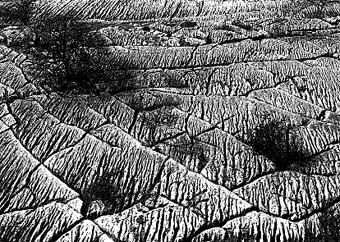

|
from the Real World 
Museet for Fotokunst presents the British photographer and physicist Bill Hirst's "Fractal Landscapes from the Real World", as a continuation of previous years' landscape exhibitions. The exhibition consists of a sequence of large and finely detailed black and white photographs, paired and grouped to demonstrate the fractal character of natural and man-made landscapes. Fractals are a recently discovered class of geometrical forms that create familiar but irregular patterns ranging over variations in size. Many people will have seen the complex, and brightly coloured examples generated by computer. But fractals are more than just a mathematical curiosity, or a computer hobbyist's plaything: they shape us and the world we live in. Details from the real world like the meanders of a river, the cragginess of a mountain or the shape of a cloud, used to be regarded as chance deviations from an otherwise tidy - rather mechanistic - view of nature. Fractals and chaos theory reveal a previously unsuspected level of ordered complexity buries within nature's apparent untidiness. Bill Hirst demonstrates the existence, and pervasive influence, of such ordered complexity, by highlighting similarities between separate, physically remote, natural and man-made landscapes. The book "Fractal Landscapes from the Real World" was published by Cornerhouse Publications. More extensive than the exhibition, it contains over 50 large tritone plates and includes a lengthy infroduction by Benoit Mandeibrot (originator offractal geometry and the central figure in its development for 30 years). He describes what fractals are, how they arise, and the reason for their far-reaching impact on science and beyond. Biography: |